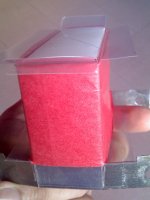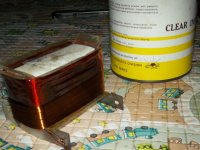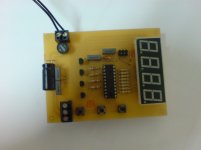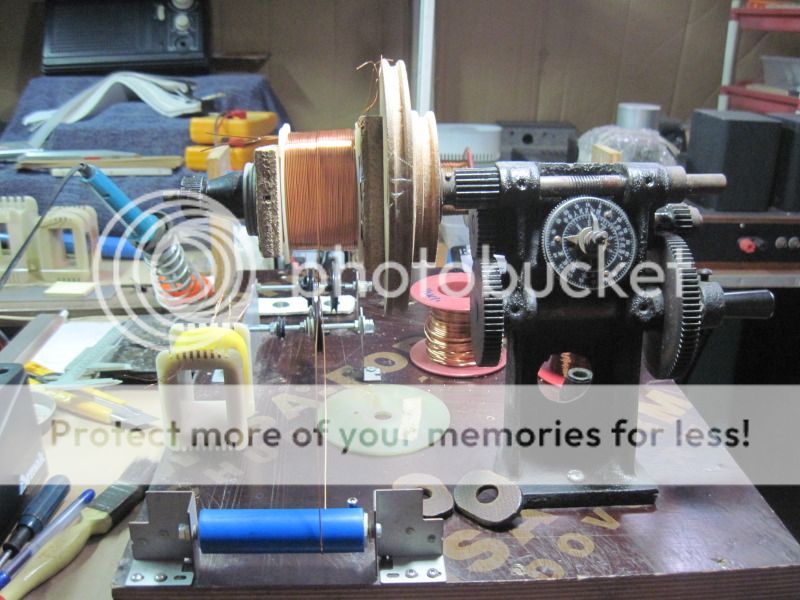HEY,
Can anyone please tell me what is the formula for finding priamary and secondory turns for a small ferrite core transformer where 220vac will be the input of priamary side and 12vac will be the output of secondory side...or can we use the EP/ES=NP/NS formula??
please help me...
Can anyone please tell me what is the formula for finding priamary and secondory turns for a small ferrite core transformer where 220vac will be the input of priamary side and 12vac will be the output of secondory side...or can we use the EP/ES=NP/NS formula??
please help me...
re: EP/ES=NP/NS
This formula won't provide the number of turns, only the turns ratio.
Determining the actual number of turns is much more involved - physically counting them or heady calculations from wire size.
This formula won't provide the number of turns, only the turns ratio.
Determining the actual number of turns is much more involved - physically counting them or heady calculations from wire size.
HEY,
Can anyone please tell me what is the formula for finding priamary and secondory turns for a small ferrite core transformer where 220vac will be the input of priamary side and 12vac will be the output of secondory side...or can we use the EP/ES=NP/NS formula??
please help me...
ferrite core, means you are looking at smps, out of scope of this thread...
so friends....what should i do please tell me how will i got to know about the ferrite core transformer,the priamary & secondory turns...everything!! related to it......
pleaseeeeee help its very very urgent!!
pleaseeeeee help its very very urgent!!
This thread covers a lot of the basics of transformers'
http://www.diyaudio.com/forums/planars-exotics/161485-step-up-transformer-design.html#post2088330
It is a long thread but as lots of very good info as it explains basics of core saturation and how to go about finding such parameters.
As well as finding the turns count of the windings and ratio of a unknown transformer.
Here is a link to a calculator that might help you.
http://www.diyaudio.com/forums/planars-exotics/161485-step-up-transformer-design.html#post2089815
This one is a good one as well but I think it assumes a square wave input and I have not tried raw calculations to check it yet,
TRANSFORMERS
You need to know the core size and type of material in order to determine the number of primary turns as per frequency and primary voltage in order to design it for no saturation of the core.
There many good threads on transformer design in this forum but I don't have a compiled list for them as they can be found very easily using the search function.
Here is the calculator that I think you are looking for and it also shows the formulas as well,
Maximum Flux Density Calculator
There a few more transformer calculators that can be found on this page,
http://www.daycounter.com/SiteMap.phtml
I hope this helps you !!
jer 🙂
http://www.diyaudio.com/forums/planars-exotics/161485-step-up-transformer-design.html#post2088330
It is a long thread but as lots of very good info as it explains basics of core saturation and how to go about finding such parameters.
As well as finding the turns count of the windings and ratio of a unknown transformer.
Here is a link to a calculator that might help you.
http://www.diyaudio.com/forums/planars-exotics/161485-step-up-transformer-design.html#post2089815
This one is a good one as well but I think it assumes a square wave input and I have not tried raw calculations to check it yet,
TRANSFORMERS
You need to know the core size and type of material in order to determine the number of primary turns as per frequency and primary voltage in order to design it for no saturation of the core.
There many good threads on transformer design in this forum but I don't have a compiled list for them as they can be found very easily using the search function.
Here is the calculator that I think you are looking for and it also shows the formulas as well,
Maximum Flux Density Calculator
There a few more transformer calculators that can be found on this page,
http://www.daycounter.com/SiteMap.phtml
I hope this helps you !!
jer 🙂
Last edited:
Hi, something new here 🙂
Back on iron trafo...
I think I must finish my trafo build as soon as possible...
But I'm not sure yet
maybe I'll show what I've been done so far
I will need suggestion, to continue or start over
Back on iron trafo...
I think I must finish my trafo build as soon as possible...
But I'm not sure yet
maybe I'll show what I've been done so far
I will need suggestion, to continue or start over
rikkit,
do you have any further info on that pdf file
not getting any hits for that either google or texas instruments
thanks
do you have any further info on that pdf file
not getting any hits for that either google or texas instruments
thanks
I think this is not good
This will be 300VA trafo that I'm going to make or maybe not.
I'm just not so confidence is this okay or not
I thing ask some suggestion here is a good way
I just use what I see around he..he... 😀,
latter
I found better "things" to use as
inter layer windings insulation
also found good trafo as a reference
here 2 pictures
what do you think, give it a try or
I must start again with better way?
Any comment greatly appreciated
This will be 300VA trafo that I'm going to make or maybe not.
I'm just not so confidence is this okay or not
I thing ask some suggestion here is a good way
I just use what I see around he..he... 😀,
latter
I found better "things" to use as
inter layer windings insulation
also found good trafo as a reference
here 2 pictures
what do you think, give it a try or
I must start again with better way?
Any comment greatly appreciated
Attachments
^yeah, why not? if i were you i'd make a wooden mandrel with which to put the bobbin into, this way you can pound on the windings using wooden mallet or a bench vise to make sure your built up coil fits the iron core....
Tony is right, look at this page: Jan's transformer article p4
Has excellent advices to follow.
Here is a 4-digit counter that I have recently built, code, eagle files, attiny2313.
metal
Has excellent advices to follow.
Here is a 4-digit counter that I have recently built, code, eagle files, attiny2313.
metal
Attachments
Last edited:
this is what i use for mandrels:
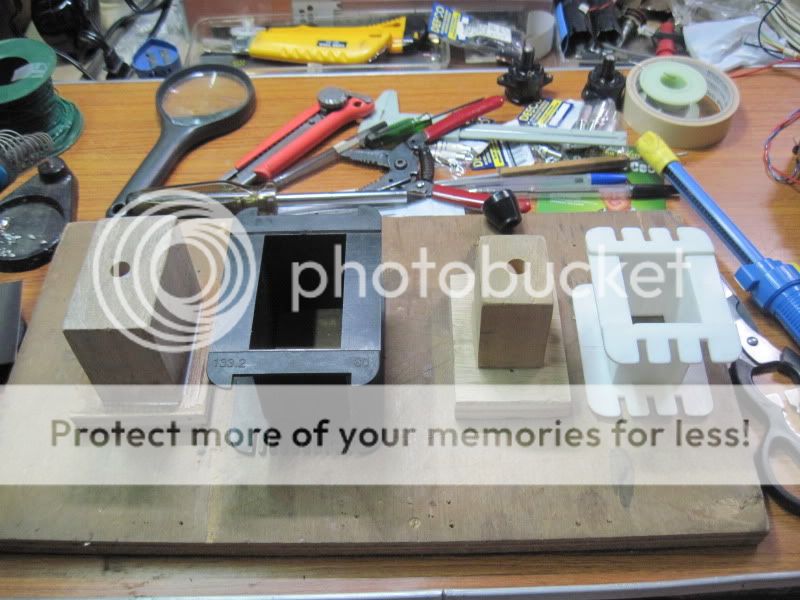

An externally hosted image should be here but it was not working when we last tested it.
sorry for OT but :
google for slup122 and up to slup127
,they are pdf files. first hit.
TI website search engine is shite. could not find opa2134 ...
google for slup122 and up to slup127
,they are pdf files. first hit.
TI website search engine is shite. could not find opa2134 ...
Last edited:
can you give a closer photo for the transformer you are winding? I want to see how the windings look
Thanks for quick reply from Tony & Metal
Very good suggestion & advice
Now I change my mind 😀
I'm planning to make bigger trafo (about 600VA) but after look at
http://www.diyaudio.com/forums/power-supplies/191730-my-latest-traffo-build-28.html
then more question appear in my head 😕
I will make bobbin for this one but the form is rectangle not square as Tony suggest.
Please tell me what the disadvantages with rectangle shape?
I want trafo that not so high that can be fit in the shorter case
Rectangle because I will use :
1 1/4 inch (32mm) center tongue stacked 6.5 inch (16.5mm)
The thickness of the laminated plate is 0.5mm & I will go bellow 1T
The bobbin I will made with "fiber" PCB
Every 1 stack complete winding, brushed with clear insulating enamel
then I have a choice to use paper or plastic for insulating.
The paper is "brown wrapping paper" &
the plastic is that what use as "laminating paper" it is can stand up to 150°C
& I guess its good to be used
but allmost Tony's trafo use paper insulator...
Again please tell me what to use here?
For finishing I'm not dip it into the insulating enamel because the winding is already insulated before & for the laminated plate just do with brush
So I'm on the right track or I must find bigger core size?
Very good suggestion & advice
Now I change my mind 😀
I'm planning to make bigger trafo (about 600VA) but after look at
http://www.diyaudio.com/forums/power-supplies/191730-my-latest-traffo-build-28.html
then more question appear in my head 😕
I will make bobbin for this one but the form is rectangle not square as Tony suggest.
Please tell me what the disadvantages with rectangle shape?
I want trafo that not so high that can be fit in the shorter case
Rectangle because I will use :
1 1/4 inch (32mm) center tongue stacked 6.5 inch (16.5mm)
The thickness of the laminated plate is 0.5mm & I will go bellow 1T
The bobbin I will made with "fiber" PCB
Every 1 stack complete winding, brushed with clear insulating enamel
then I have a choice to use paper or plastic for insulating.
The paper is "brown wrapping paper" &
the plastic is that what use as "laminating paper" it is can stand up to 150°C
& I guess its good to be used
but allmost Tony's trafo use paper insulator...
Again please tell me what to use here?
For finishing I'm not dip it into the insulating enamel because the winding is already insulated before & for the laminated plate just do with brush
So I'm on the right track or I must find bigger core size?
Last edited:
- Status
- Not open for further replies.
- Home
- Amplifiers
- Power Supplies
- Iron Core Transformer Formula
 @Shams, posting in all caps is against forum rules....please do not do it again...
@Shams, posting in all caps is against forum rules....please do not do it again...